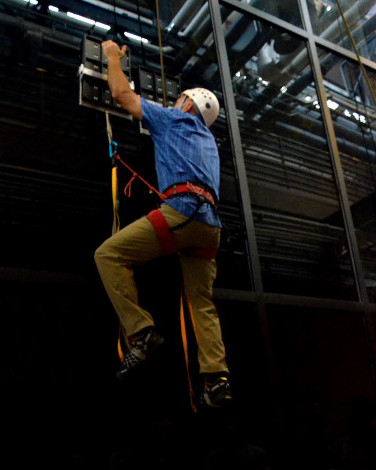This article is more than 1 year old
SPIDER-TROOP, Spider-troop, does whatever a spider troop can
Man uses sucker paddles to scale a 25-foot sheer glass wall
Mad military boffinry agency DARPA has come up with the latest iteration of a fan-favourite tech – gecko-inspired climbing pads that will allow GI Joes to scale walls like Spider-Man.
The Defence Advanced Research Projects Agency (DARPA) has used its Z-Man project to get the first known example of a human climbing a 25-foot (7.62m) glass wall with nothing other than handheld paddles.
The 218-pound (99kg) climber went up and down twice, once with an additional 50lb (22kg) load, using the lizard-inspired paddles, which have been made from a polymer microstructure technology specially developed for DARPA by Draper Laboratory in Cambridge, Massachusetts.
The agency envisions squads of soldiers using the Z-Man sucker-pads to reduce the risk of finding higher ground in combat situations.
“Historically, gaining the high ground has always been an operational advantage for war-fighters, but the climbing instruments on which they’re frequently forced to rely - tools such as ropes and ladders - have not advanced significantly for millennia,” DARPA said.
“Not only can the use of such tools be overt and labour intensive, they also only allow for sequential climbing whereby the first climber often takes on the highest risk.”

The Z-Man project aim is to take inspiration from the animals to help soldiers carrying full combat gear to scale vertical walls.
“The gecko is one of the champion climbers in the Animal Kingdom, so it was natural for DARPA to look to it for inspiration in overcoming some of the manoeuvre challenges that US forces face in urban environments,” said Dr Matt Goodman, the DARPA programme manager for Z-Man.
“Like many of the capabilities that the Department of Defence pursues, we saw with vertical climbing that nature had long since evolved the means to efficiently achieve it. The challenge to our performer team was to understand the biology and physics in play when geckos climb and then reverse-engineer those dynamics into an artificial system for use by humans.”
Geckos have such powerful adhesive pressure in each limb that they can hang their entire bodies by just one toe. Each toe has a microscopic structure of tiny stalk-like setae – 100 microns long and two across. Each seta has in turn a bundle of hundreds of tips called spatulae – in essence, very fine hairs just 200 nanometres in diameter at their widest - which branch out and touch the climbing surface.
It is the size and shape of these fine hairs that allow the geckos to climb, not any specific surface chemistry, so it’s a design that can theoretically be copied, making them quite the inspiration for Spider-Man enthused boffins.
Way back in 2007, an Italian boffin proposed that a Spider-Man suit that would allow the wearer to scale walls and hang off ceilings should be possible, using gloves and boots with branching carbon nanotubes to emulate gecko toes and web strands from cables of nanotube fibres.
For the Z-Man project, the Draper Laboratory created new micro- and nanofabrication techniques to make the tiny hair structures of the gecko toe, while DARPA worked on supporting the extra weight of people. In order to suction off and on without ever toppling, the agency had to work out how to give the paddles enough adhesive force acting both parallel and perpendicular to the surface to keep the human stuck on.
DARPA plans to continue testing to perfect the technology. ®
